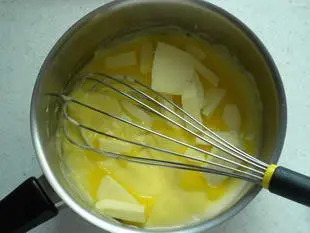The blog of cooking-ez.com
Creams in pastry
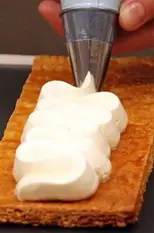
In this post, I propose you to make a small tour of the different creams in pastry.
If you like to make them at home, you have already noticed the many creams that exist for the different desserts: Chantilly, custard, diplomat, Bavarian, etc. etc.
Each one more delicious than the other, they are the keystone of French pastry making, what makes a good part of its success in the world, the basics that any good pastry chef must absolutely master, and a challenge for the amateurs that we are.
If you like to make them at home, you have already noticed the many creams that exist for the different desserts: Chantilly, custard, diplomat, Bavarian, etc. etc.
Each one more delicious than the other, they are the keystone of French pastry making, what makes a good part of its success in the world, the basics that any good pastry chef must absolutely master, and a challenge for the amateurs that we are.
8,316 17 4.5
Last modified on: March 12th 2022
Keywords for this post:PastryCreamsOverviewCustardTourCreams in pastry
Let's look at the main creams in the range
I could have listed them one by one, indicating what is in them, but for many of them there is a link, such as for the cream B we start from cream A and add this or that.All this creates a kind of hierarchy in the creams, and that's how I'm going to try to tell you about it.
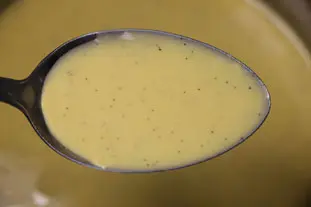 | At the beginning, the mother of all egg-based creams, if you can call it that, is the custard (crème anglaise in french) It's a simple recipe: milk, sugar, egg yolks and vanilla, cooked gently until smooth, that's all. Example of use: Profiteroles. |
Then there are the creams that contain custard, which are :
| 1) Bavarian cream = Custard + gelatin + whipped cream: In the hot custard, add gelatin, let it cool, then gently add whipped cream. Example of use: Various cakes and desserts. | |
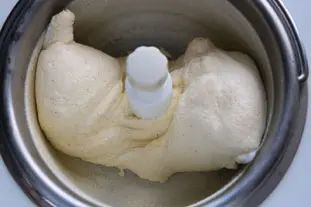 | 2) Ice cream (or vanilla ice cream) = Custard + fresh cream: In the cold custard, fresh cream is added, then the mixture is blended in an ice cream maker. Example of use: Various ice creams or ice cream. |
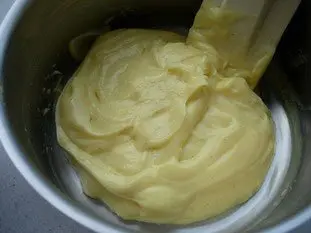 | 3) Pastry cream = Custard + cornstarch: Cook until boiling, you get a much thicker cream. Example of use: To garnish éclairs. |
Then the creams, based on custard :
| 4) Crème mousseline = Pastry cream + butter: In the hot pastry cream, add butter and whip vigorously to aerate. Example of use: A strawberry cake. |
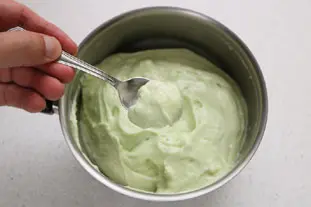 | 5) Chiboust cream = Pastry cream + meringue: In the cold pastry cream, we add raw meringue (French or Italian) and we incorporate delicately. Example of use: A saint-honoré. |
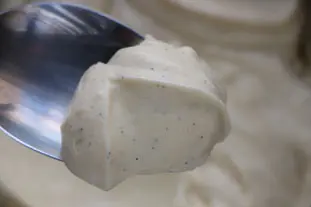 | 6) Diplomat cream = Custard + gelatine + whipped cream: Add gelatine to the hot custard, let it cool, then gently fold in whipped cream. Example of use: Various cakes and entremets (the diplomat cream is so good that it's impossible to resist...). |
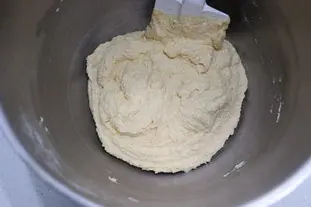 | 7) Frangipane cream = Pastry cream + almond cream: In the almond cream, cold pastry cream is added. Example of use: Filling of galette des rois with frangipane cream. |
To complete the table, 2 other creams related to the previous ones:
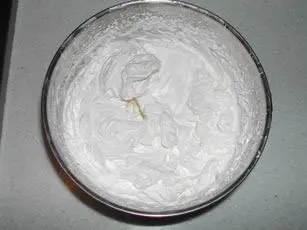 | 8) Whipped cream = Crème fraiche + sugar: In the cold crème fraiche, we add sugar, we whip to make it rise. Example of use: Cream puffs. Tip: replace half of the crème fraiche with mascarpone, even more delicious and more stable over time. |
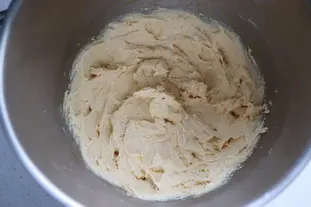 | 9) Almond cream = Almond powder + butter + eggs + sugar + cornstarch + rum: We mix all the ingredients with a mixer to aerate the whole. Example of use: Topping of galette des rois with almond cream. |
There are still many others, but with these alone you already have a tasty panorama of what is possible in pastry.
Let's add to this that, in addition, you can vary the flavors, if at the beginning it is often vanilla flavor, each cream can be declined in delicious variations as chocolate, coffee, fruits, alcohols, herbs, the only limit is your imagination, which is still pleasant.
By the way, when I say that these creams are a challenge for a pastry chef, it's because they are not that easy to make, you have to be precise and very careful, you quickly over or under cook.
The custard, if it is the origin of everything, is thus quite delicate to succeed perfectly, especially at the beginning: not cooked enough it is vanilla milk, and too much it is full of lumps.
And to finish, here is a little diagram that summarizes the links between these creams:
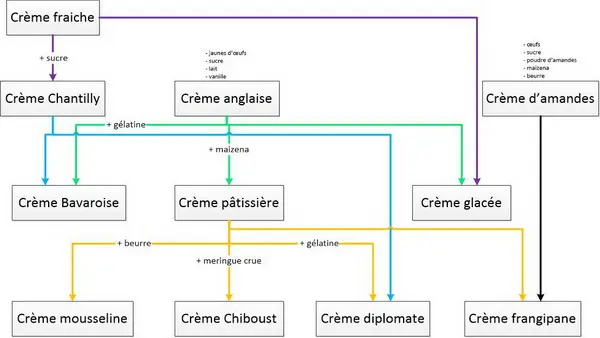
Lasts posts
Wipe meats and fish before cooking
When you want to cook meat or fish, there's a very simple yet very important step to take before you even start: It's to dry, or wipe, each side of the meat or fish, sometimes called "dabbing" or "sponging". But why? And how? Let me explain.1,5065 April 14th 2024
Toss the salad
When you've finished preparing a salad, green or otherwise, it's usually time to add the dressing and toss. It's often said to "toss the salad", which means to season and mix. Is it easy? Not so easy...2,8485 March 8th 2024
Half milk, half cream
In a multitude of recipes, savoury or sweet, milk is used as the main ingredient, or at least as the main liquid ingredient. Milk is used instead of water, for example, because milk contains a proportion of fat, which adds roundness and softness to the recipe. This mellowness is very pleasant on...2,688 February 27th 2024
Cutting soft cheeses
As you may have already noticed, when you have to use a "soft" cheese in a recipe - their exact name is "soft cheese" - such as Camembert, Munster or Mont d'or, it's not easy to make anything other than thick slices.2,8075 February 20th 2024
It's spinning too fast!
When you need to grate or slice vegetables, you generally use an electric machine that does all the work: a food processor, a mixer with a "slicer" extension or similar. Are these machines really suitable? Generally speaking, yes of course, but there's one criterion that often poses a problem,...5,7725 November 12th 2023
Other pages you may also like
Wipe meats and fish before cooking
When you want to cook meat or fish, there's a very simple yet very important step to take before you even start: It's to dry, or wipe, each side of the meat or fish, sometimes called "dabbing" or "sponging". But why? And how? Let me explain.1,5065 April 14th 2024
Half milk, half cream
In a multitude of recipes, savoury or sweet, milk is used as the main ingredient, or at least as the main liquid ingredient. Milk is used instead of water, for example, because milk contains a proportion of fat, which adds roundness and softness to the recipe. This mellowness is very pleasant on...2,688 February 27th 2024
Don't throw away your pizza crusts
You've probably already noticed that at the end of a pizza meal, at least half of the participants have left the crusts in the boxes or on the plates that many don't eat. Naturally, one would tend to put them "to the birds", or worse, to throw them away, and it's a shame because they are in fact...4,7964.9 April 22th 2023
The art of the charlotte
In cooking, a charlotte is a delicious moulded dessert, with biscuits around the outside that have been soaked in a flavoured syrup, filled with a light cream or mousse. The charlotte is left to set in the fridge before being turned out and served in slices. It is very light and a lovely sweet...38K4.3 February 27th 2013
What happens to the bread when you make it?
This bread that we eat every day, and that our baker makes for us, what happens during its manufacture so that it becomes bread? I will try to answer this question, and to summarize the complex alchemy that takes place.8,7584.9 May 28th 2021
Post your comment or question
Follow this page
If you are interested in this page, you can "follow" it, by entering your email address here. You will then receive a notification immediately each time the page is modified or a new comment is added. Please note that you will need to confirm this following.
Note: We'll never share your e-mail address with anyone else.
Alternatively: you can subscribe to the mailing list of cooling-ez.com , you will receive a e-mail for each new recipe published on the site.
